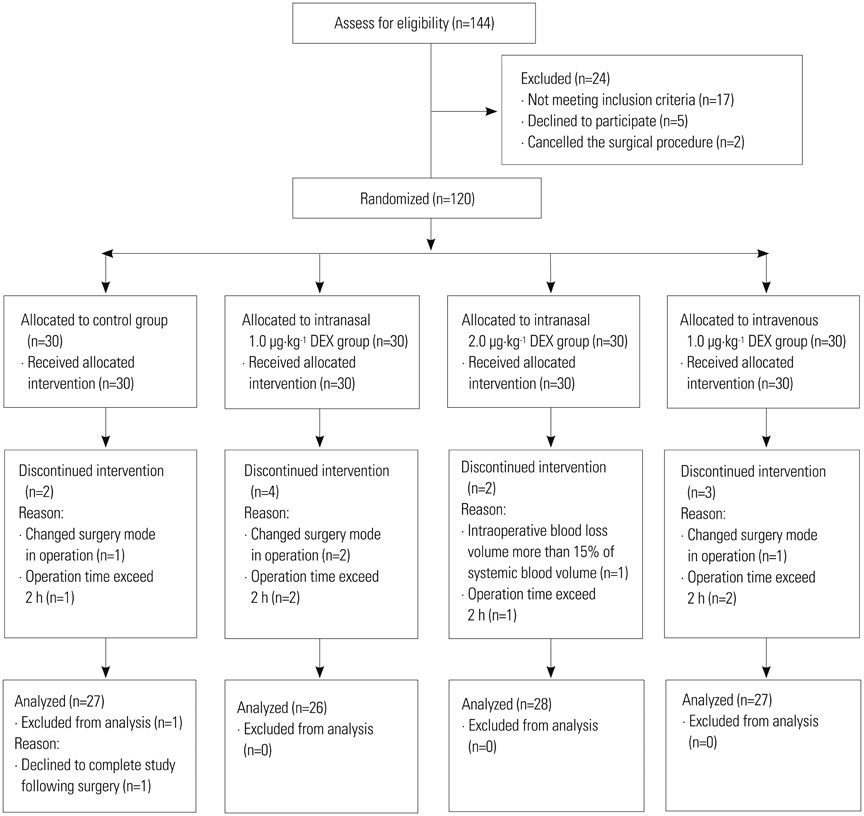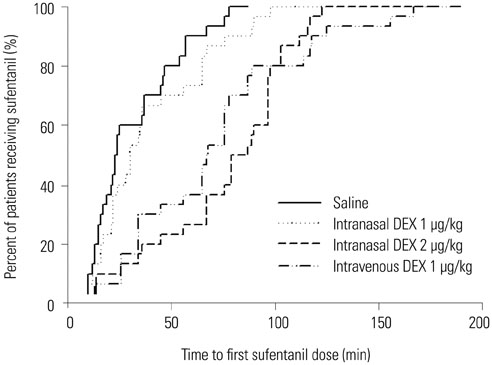Yonsei Med J.
2016 Jul;57(4):998-1005. 10.3349/ymj.2016.57.4.998.
Intranasally Administered Adjunctive Dexmedetomidine Reduces Perioperative Anesthetic Requirements in General Anesthesia
- Affiliations
-
- 1Department of Anesthesiology, The Affiliated Hospital of School of Medicine of Ningbo University, Ningbo, Zhejiang, China.
- 2Department of Anesthesiology, The Affiliated People's Hospital of Jiangsu University, Zhenjiang, Jiangsu, China. chenzheng198590@sina.com
- KMID: 2374135
- DOI: http://doi.org/10.3349/ymj.2016.57.4.998
Abstract
- PURPOSE
Intranasal dexmedetomidine is an effective sedative for premedication and is regularly used to reduce preoperative tension and anxiety in children. This study aimed to assess the effect of intranasally adjunctive dexmedetomidine on perioperative sedative and analgesic requirements in adults.
MATERIALS AND METHODS
Patients were randomly divided into four groups to receive preoperative administration of saline, intranasal dexmedetomidine 1 µg/kg and 2 µg/kg, and intravenous dexmedetomidine 1 µg/kg, respectively. Propofol and remifentanil were target-controlled infused to maintain intraoperative bispectral index at 45-55 and blood pressure at baseline value±20%. Sufentanil was administered to maintain postoperative visual analogue scale ≤3. Perioperative anesthetics requirements were compared using nonparametric tests.
RESULTS
Intranasal dexmedetomidine significantly attenuated propofol requirements for anesthesia induction and maintenance in a dose-dependent manner. Patients given intranasal dexmedetomidine 2 µg/kg required less remifentanil for anesthesia maintenance. The first postoperative request for sufentanil analgesia was delayed in patients given intranasal dexmedetomidine 2 µg/kg. The anesthetics-sparing effect of intranasal dexmedetomidine was significantly weaker than intravenous dexmedetomidine at the same dose of 1 µg/kg. The incidences of adverse events, including hemodynamic instability and delayed recovery, were comparable with and without intranasal dexmedetomidine.
CONCLUSION
Intranasal administration of dexmedetomidine can reduce perioperative anesthetic requirements, and a dose of dexmedetomidine 2 µg/kg produces a better effect in adults. The anesthetics-sparing effect of intranasal dexmedetomidine 1 µg/kg is less than that with the same intravenous dose of dexmedetomidine.
MeSH Terms
-
*Administration, Intranasal
Adult
*Anesthesia, General
Child
Dexmedetomidine/*administration & dosage/adverse effects/*pharmacology
Double-Blind Method
Female
Humans
Hypnotics and Sedatives/*administration & dosage/adverse effects/*pharmacology
Male
Middle Aged
Pain Measurement
*Perioperative Care
Premedication
Dexmedetomidine
Hypnotics and Sedatives
Figure
Cited by 1 articles
-
Comparison of Dexmedetomidine and Fentanyl as an Adjuvant to Ropivacaine for Postoperative Epidural Analgesia in Pediatric Orthopedic Surgery
Sang Jun Park, Seokyung Shin, Shin Hyung Kim, Hyun Woo Kim, Seung Hyun Kim, Hae Yoon Do, Yong Seon Choi
Yonsei Med J. 2017;58(3):650-657. doi: 10.3349/ymj.2017.58.3.650.
Reference
-
1. Kaur M, Singh PM. Current role of dexmedetomidine in clinical anesthesia and intensive care. Anesth Essays Res. 2011; 5:128–133.
Article2. Arcangeli A, D'Alò C, Gaspari R. Dexmedetomidine use in general anaesthesia. Curr Drug Targets. 2009; 10:687–695.
Article3. Grassin-Delyle S, Buenestado A, Naline E, Faisy C, Blouquit-Laye S, Couderc LJ, et al. Intranasal drug delivery: an efficient and noninvasive route for systemic administration: focus on opioids. Pharmacol Ther. 2012; 134:366–379.
Article4. Jia JE, Chen JY, Hu X, Li WX. A randomised study of intranasal dexmedetomidine and oral ketamine for premedication in children. Anaesthesia. 2013; 68:944–949.
Article5. Ghali AM, Mahfouz AK, Al-Bahrani M. Preanesthetic medication in children: a comparison of intranasal dexmedetomidine versus oral midazolam. Saudi J Anaesth. 2011; 5:387–391.
Article6. Cheung CW, Ng KF, Liu J, Yuen MY, Ho MH, Irwin MG. Analgesic and sedative effects of intranasal dexmedetomidine in third molar surgery under local anaesthesia. Br J Anaesth. 2011; 107:430–437.
Article7. Cheung CW, Qiu Q, Liu J, Chu KM, Irwin MG. Intranasal dexmedetomidine in combination with patient-controlled sedation during upper gastrointestinal endoscopy: a randomised trial. Acta Anaesthesiol Scand. 2015; 59:215–223.
Article8. Zhang X, Bai X, Zhang Q, Wang X, Lu L. The safety and efficacy of intranasal dexmedetomidine during electrochemotherapy for facial vascular malformation: a double-blind, randomized clinical trial. J Oral Maxillofac Surg. 2013; 71:1835–1842.
Article9. Yuen VM, Irwin MG, Hui TW, Yuen MK, Lee LH. A double-blind, crossover assessment of the sedative and analgesic effects of intranasal dexmedetomidine. Anesth Analg. 2007; 105:374–380.
Article10. Liu N, Chazot T, Hamada S, Landais A, Boichut N, Dussaussoy C, et al. Closed-loop coadministration of propofol and remifentanil guided by bispectral index: a randomized multicenter study. Anesth Analg. 2011; 112:546–557.
Article11. Le Guen M, Liu N, Tounou F, Augé M, Tuil O, Chazot T, et al. Dexmedetomidine reduces propofol and remifentanil requirements during bispectral index-guided closed-loop anesthesia: a doubleblind, placebo-controlled trial. Anesth Analg. 2014; 118:946–955.
Article12. Wang SS, Zhang MZ, Sun Y, Wu C, Xu WY, Bai J, et al. The sedative effects and the attenuation of cardiovascular and arousal responses during anesthesia induction and intubation in pediatric patients: a randomized comparison between two different doses of preoperative intranasal dexmedetomidine. Paediatr Anaesth. 2014; 24:275–281.
Article13. Ambi US, Joshi C, Ganeshnavar A, Adarsh E. Intranasal dexmedetomidine for paediatric sedation for diagnostic magnetic resonance imaging studies. Indian J Anaesth. 2012; 56:587–588.
Article14. Ibrahim M. A prospective, randomized, double blinded comparison of intranasal dexmedetomodine vs intranasal ketamine in combination with intravenous midazolam for procedural sedation in school aged children undergoing MRI. Anesth Essays Res. 2014; 8:179–186.
Article15. Iirola T, Vilo S, Manner T, Aantaa R, Lahtinen M, Scheinin M, et al. Bioavailability of dexmedetomidine after intranasal administration. Eur J Clin Pharmacol. 2011; 67:825–831.
Article16. Vivien B, Di Maria S, Ouattara A, Langeron O, Coriat P, Riou B. Overestimation of Bispectral Index in sedated intensive care unit patients revealed by administration of muscle relaxant. Anesthesiology. 2003; 99:9–17.
Article17. Ngwenyama NE, Anderson J, Hoernschemeyer DG, Tobias JD. Effects of dexmedetomidine on propofol and remifentanil infusion rates during total intravenous anesthesia for spine surgery in adolescents. Paediatr Anaesth. 2008; 18:1190–1195.
Article18. Bekker A, Sturaitis M, Bloom M, Moric M, Golfinos J, Parker E, et al. The effect of dexmedetomidine on perioperative hemodynamics in patients undergoing craniotomy. Anesth Analg. 2008; 107:1340–1347.
Article19. Angst MS, Ramaswamy B, Davies MF, Maze M. Comparative analgesic and mental effects of increasing plasma concentrations of dexmedetomidine and alfentanil in humans. Anesthesiology. 2004; 101:744–752.
Article20. Khan ZP, Ferguson CN, Jones RM. alpha-2 and imidazoline receptor agonists. Their pharmacology and therapeutic role. Anaesthesia. 1999; 54:146–165.
Article21. Wu X, Hang LH, Chen YF, Wang H, Shao DH, Chen Z. Remifentanil requirements for preventing motor response to skin incision in healthy women anesthetized with combinations of propofol and dexmedetomidine titrated to similar Bispectral Index (BIS) values. Ir J Med Sci. 2015; 184:805–811.
Article22. Gurbet A, Basagan-Mogol E, Turker G, Ugun F, Kaya FN, Ozcan B. Intraoperative infusion of dexmedetomidine reduces perioperative analgesic requirements. Can J Anaesth. 2006; 53:646–652.
Article23. Al-Zaben KR, Qudaisat IY, Al-Ghanem SM, Massad IM, Al-Mustafa MM, Al-Oweidi AS, et al. Intraoperative administration of dexmedetomidine reduces the analgesic requirements for children undergoing hypospadius surgery. Eur J Anaesthesiol. 2010; 27:247–252.
Article24. Unlugenc H, Gunduz M, Guler T, Yagmur O, Isik G. The effect of pre-anaesthetic administration of intravenous dexmedetomidine on postoperative pain in patients receiving patient-controlled morphine. Eur J Anaesthesiol. 2005; 22:386–391.
Article25. Wang T, Ge S, Xiong W, Zhou P, Cang J, Xue Z. Effects of different loading doses of dexmedetomidine on bispectral index under stepwise propofol target-controlled infusion. Pharmacology. 2013; 91:1–6.
Article26. Kasuya Y, Govinda R, Rauch S, Mascha EJ, Sessler DI, Turan A. The correlation between bispectral index and observational sedation scale in volunteers sedated with dexmedetomidine and propofol. Anesth Analg. 2009; 109:1811–1815.
Article27. Yuen VM, Hui TW, Irwin MG, Yao TJ, Wong GL, Yuen MK. Optimal timing for the administration of intranasal dexmedetomidine for premedication in children. Anaesthesia. 2010; 65:922–929.
Article28. Talon MD, Woodson LC, Sherwood ER, Aarsland A, McRae L, Benham T. Intranasal dexmedetomidine premedication is comparable with midazolam in burn children undergoing reconstructive surgery. J Burn Care Res. 2009; 30:599–605.
Article29. Mekitarian Filho E, Robinson F, de Carvalho WB, Gilio AE, Mason KP. Intranasal dexmedetomidine for sedation for pediatric computed tomography imaging. J Pediatr. 2015; 166:1313–1315.e1.
Article
- Full Text Links
- Actions
-
Cited
- CITED
-
- Close
- Share
- Similar articles
-
- Dexmedetomidine as a non-triggering anesthetic agent in a patient with MELAS syndrome and systemic sepsis: A case report
- Clinical applications of alpha2 adrenoceptor agonist
- Opioid-free anesthesia using continuous dexmedetomidine and lidocaine infusions in spine surgery
- Regional anesthetic management of elderly patients
- Application of Monitored Anesthesia Care Using Dexmedetomidine to Common Oral and Maxillofacial Trauma Cases




